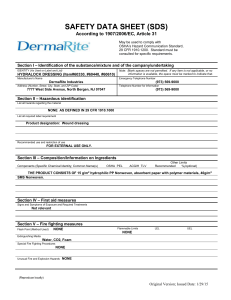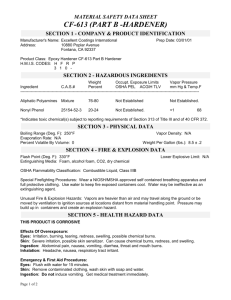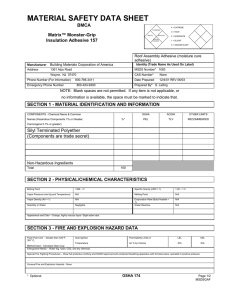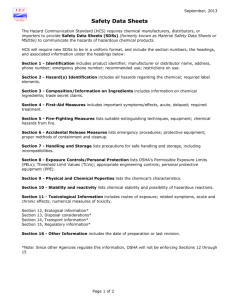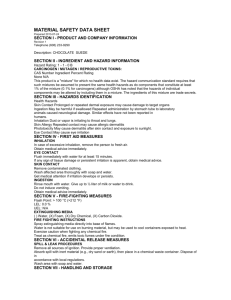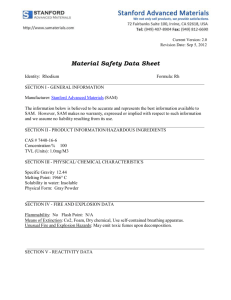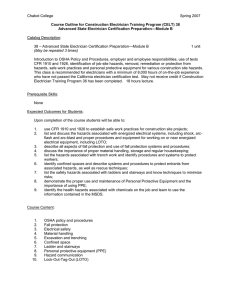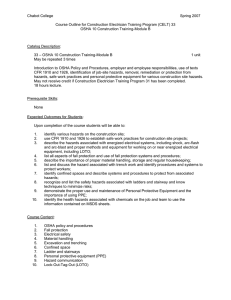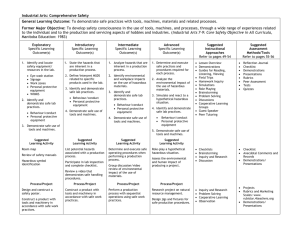SDS
advertisement
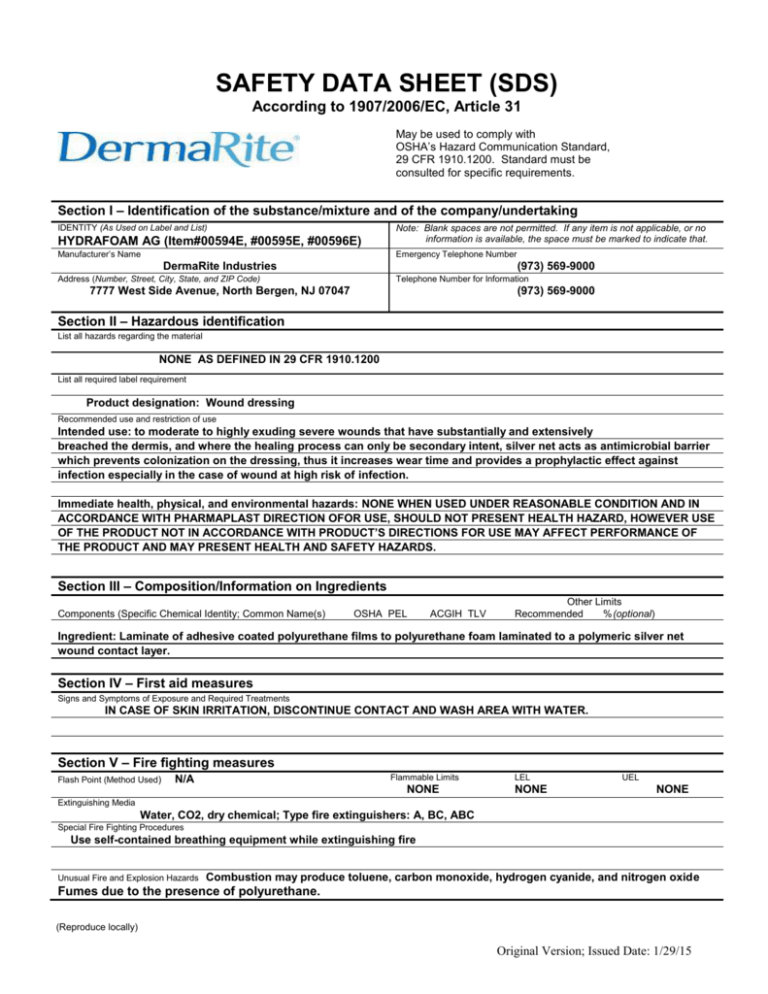
SAFETY DATA SHEET (SDS) According to 1907/2006/EC, Article 31 May be used to comply with OSHA’s Hazard Communication Standard, 29 CFR 1910.1200. Standard must be consulted for specific requirements. Section I – Identification of the substance/mixture and of the company/undertaking HYDRAFOAM AG (Item#00594E, #00595E, #00596E) Note: Blank spaces are not permitted. If any item is not applicable, or no information is available, the space must be marked to indicate that. Manufacturer’s Name Emergency Telephone Number IDENTITY (As Used on Label and List) DermaRite Industries (973) 569-9000 Address (Number, Street, City, State, and ZIP Code) Telephone Number for Information 7777 West Side Avenue, North Bergen, NJ 07047 (973) 569-9000 Section II – Hazardous identification List all hazards regarding the material NONE AS DEFINED IN 29 CFR 1910.1200 List all required label requirement Product designation: Wound dressing Recommended use and restriction of use Intended use: to moderate to highly exuding severe wounds that have substantially and extensively breached the dermis, and where the healing process can only be secondary intent, silver net acts as antimicrobial barrier which prevents colonization on the dressing, thus it increases wear time and provides a prophylactic effect against infection especially in the case of wound at high risk of infection. Immediate health, physical, and environmental hazards: NONE WHEN USED UNDER REASONABLE CONDITION AND IN ACCORDANCE WITH PHARMAPLAST DIRECTION OFOR USE, SHOULD NOT PRESENT HEALTH HAZARD, HOWEVER USE OF THE PRODUCT NOT IN ACCORDANCE WITH PRODUCT’S DIRECTIONS FOR USE MAY AFFECT PERFORMANCE OF THE PRODUCT AND MAY PRESENT HEALTH AND SAFETY HAZARDS. Section III – Composition/Information on Ingredients Components (Specific Chemical Identity; Common Name(s) OSHA PEL ACGIH TLV Other Limits Recommended %(optional) Ingredient: Laminate of adhesive coated polyurethane films to polyurethane foam laminated to a polymeric silver net wound contact layer. Section IV – First aid measures Signs and Symptoms of Exposure and Required Treatments IN CASE OF SKIN IRRITATION, DISCONTINUE CONTACT AND WASH AREA WITH WATER. Section V – Fire fighting measures Flash Point (Method Used) Flammable Limits N/A NONE LEL NONE UEL NONE Extinguishing Media Water, CO2, dry chemical; Type fire extinguishers: A, BC, ABC Special Fire Fighting Procedures Use self-contained breathing equipment while extinguishing fire Unusual Fire and Explosion Hazards Combustion may produce toluene, carbon monoxide, hydrogen cyanide, and nitrogen oxide Fumes due to the presence of polyurethane. (Reproduce locally) Original Version; Issued Date: 1/29/15 HYDRAFOAM AG– page 2 of 3 Section VI – Accidental release measures Steps to Be Taken in Case Material Is Released or Spilled Not applicable. Respiratory Protection (Specify Type) Not applicable. Not applicable. No Ventilation Ventilation Ventilation Not necessary Not necessary Not necessary No No No Protective Gloves Protective Gloves Normal work clothes Normal work clothes Other Protective Clothing or Equipment Normal working conditions . Work/Hygienic Practices Section VII– Handling and Storage Precautions to Be Taken in Handling and Storing Keep away from heat, sparks or flames. Storage in cool, dry place. UV rays may cause surface discoloration (yellowing). This does not affect the foam quality. Incompatibilities n/a Section VIII – Exposure controls/personal protection OSHA’s Permissible Exposure Limits (PELs) N/A Threshold limit values (TLVs) N/A Appropriate engineering controls NONE Personal protective equipment (PPE) NONE Section IX – Physical and chemical properties Boiling Point N/A Vapor Density (AIR = 1) At 20°C Solubility in Water N/A Specific Gravity (H2O = 1) N/A Melting Point N/A Evaporation Rate (Butyl Acetate = 1) N/A Negligible Appearance and Odor White foam covered with skin color PU film with no characteristic odor. Section X – Stability and Reactivity Data Stability Unstable Conditions to Avoid AVOID HEAT, SPARKS AND OPEN FLAMES. Stable X Incompatibility (Materials to Avoid) HYDROCARBONS, CARBON MONOXIDE, CARBON DIOXIDE Hazardous Decomposition or Byproducts NONE KNOWN Hazardous Polymerization HYDRAFOAM AG – page 3 of 3 May Occur Will Not Occur X (Reproduce locally) Original Version; Issued Date: 1/29/15 Section XI – Toxicological Information Route(s) of Entry: Inhalation? Skin? NO YES Ingestion? NO Health Hazards (Acute and Chronic) NONE ANTICIPATED Carcinogencity: NTP? NONE ANTICIPATED IARC Monographs? NO NO OSHA Regulated? NO Signs and Symptoms of Exposure NONE ANTICIPATED Medical Conditions Generally Aggravated by Exposure NONE Emergency and first aid procedures IN CASE OF SKIN IRRITATION, DISCONTINUE CONTACT AND WASH AREA WITH WATER. Section XII – Ecological Information Not available Section XIII – Disposal Consideration Waste Disposal Method No hazard. The product can be disposed of according to relevant national or local regulations pertaining to the disposal on non-hazardous waste. No special requirement. Section XIV– Transport Information No special precautions Section XV– Regulatory Information Not available Section XVI – Other Information NONE Date Prepared 1/29/2015 Signature of Preparer (optional) (Reproduce locally) THE INFORMATION AND RECOMMENDATIONS IN THIS DATA SHEET ARE BELIEVED TO BE CORRECT AND RELIABLE. HOWEVER THE DATA IS OFFERED FOR CONSIDERATION AND VERIFICATION BY THE USER AND DERMARITE INDUSTRIES LLC OFFERS NO GUARANTEE, WARRANT OR REPRESENTATION AS TO THE ACCURACY OR COMPLETENESS OF THE DATA Original Version; Issued Date: 1/29/15
